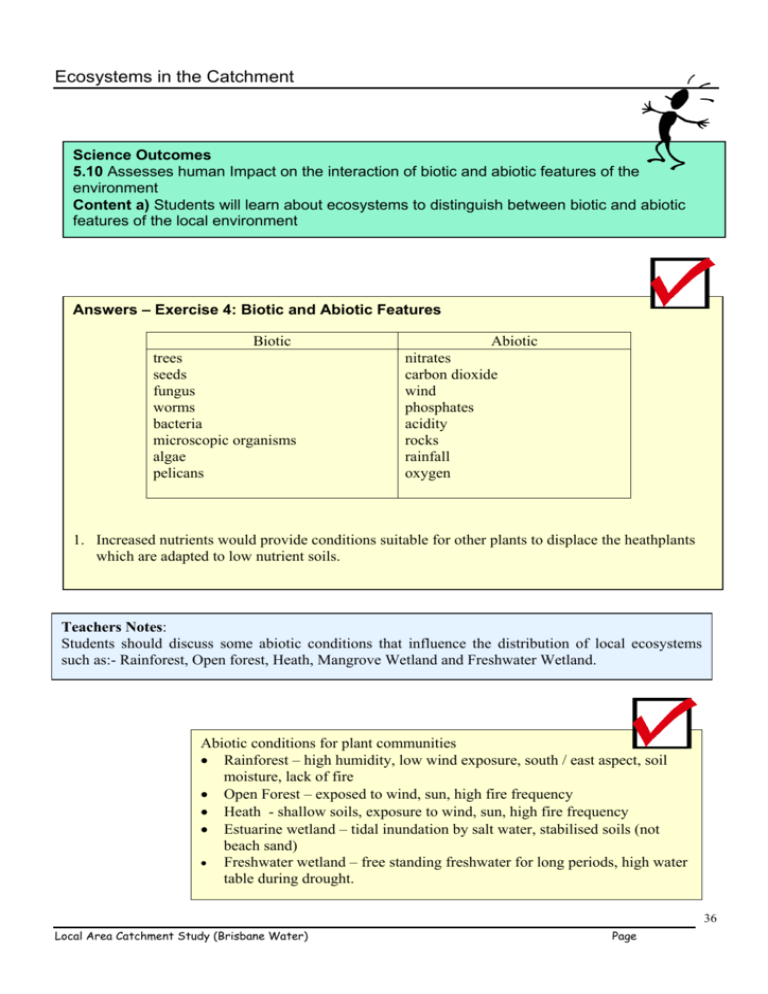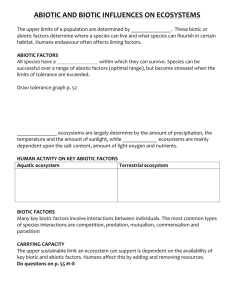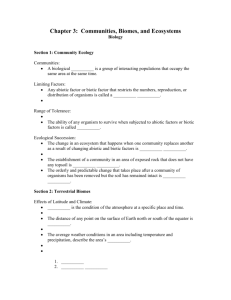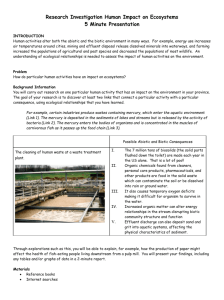Part 4 - Ecosystems
advertisement

Ecosystems in the Catchment Science Outcomes 5.10 Assesses human Impact on the interaction of biotic and abiotic features of the environment Content a) Students will learn about ecosystems to distinguish between biotic and abiotic features of the local environment Answers – Exercise 4: Biotic and Abiotic Features Biotic trees seeds fungus worms bacteria microscopic organisms algae pelicans Abiotic nitrates carbon dioxide wind phosphates acidity rocks rainfall oxygen 1. Increased nutrients would provide conditions suitable for other plants to displace the heathplants which are adapted to low nutrient soils. Teachers Notes: Students should discuss some abiotic conditions that influence the distribution of local ecosystems such as:- Rainforest, Open forest, Heath, Mangrove Wetland and Freshwater Wetland. Abiotic conditions for plant communities • Rainforest – high humidity, low wind exposure, south / east aspect, soil moisture, lack of fire • Open Forest – exposed to wind, sun, high fire frequency • Heath - shallow soils, exposure to wind, sun, high fire frequency • Estuarine wetland – tidal inundation by salt water, stabilised soils (not beach sand) • Freshwater wetland – free standing freshwater for long periods, high water table during drought. 36 Local Area Catchment Study (Brisbane Water) Page Ecosystems An ecosystem is made up of groups of organisms (bacteria, animals, fungi and plants) interacting with each other and the non-living environment (water, soil, salts, oxygen, temperature, acidity etc). Ecosystems are extremely complex but as people are such an influential part of them it’s important for scientists to study and learn how they work. We need this knowledge to avoid making mistakes that damage the environment and make it worse for future generations. Exercise 4: Biotic (Living) and Abiotic (Non-living) Features Classify the following parts of an ecosystem into biotic (living) and abiotic (non-living) features. Present your information in the table and then add 5 more biotic and 5 more abiotic examples. fungus, acidity, oxygen, carbon dioxide, worms, rocks, microscopic plankton, trees, wind, rain, algae, seeds, phosphates, bacteria, pelicans, leaf mulch, nitrates. Biotic Abiotic Ecosystems Many factors determine what types of plants and animals can survive in any given place. • The structure of the soil and the amount of water and type of nutrients it contains. • The slope of the land effects exposure to sun, frost and wind. • Other organisms may provide shelters like tree hollows for nesting or they may be predators, pollinators or food. • The frequency of fires, floods or drought might be important. When scientists measure all these things in a given place they are describing an ecosystem. Communities A community is all the living things that characterise an environment. The sandstone heath communities in places like Brisbane Water National Park are famous for their wildflowers. The poor Hawkesbury Sandstone soils support a fantastic variety of plants. Perhaps it’s because no single species is able to dominate a place with so few nutrients. If this is correct, what would you expect to happen to a heath that gets ‘fertilised’ by polluted urban runoff? 37 Local Area Catchment Study (Brisbane Water) Page Science outcome 4.10 (b) Students will learn about ecosystems to describe how producers, consumers and decomposers in Australian ecosystems are related, using food chains and food webs Answers – Exercise 5: Producers and Consumers 1. Producers Algae, Ist order consumer prawn, 2nd order consumer fish, 3rd order consumer shark 2. Herbivore is the prawn 3. Human Energy in the Community 1. A common method is to measure the dry weight or biomass of each trophic level. (The most accurate method is calorimetric (burn a representative sample of organisms at each level of the food pyramid and calculate the energy released as heat). 2. As energy is lost from the system (as respiratory heat loss) there is less energy available for the top consumers. A rule of thumb is that only about 10% of the energy contained in one trophic level gets transferred to the next level. The biomass of the carnivore population should be about 10% of the biomass of the herbivore population. 3. Humans can choose which trophic level they belong to. More people can be supported on the wheat than on the chooks that eat it. The demand for agricultural land would decline if humans stepped down a level in the food chain. 4. With less energy available top carnivores need larger areas to extract sufficient food. 5. A nature reserve needs to be large enough to contain a viable population of animals that have large territories. Viable means that there need to be enough territories or links to neighbouring territories to avoid the effects of inbreeding 6. Bio-accumulation occurs when pollutants such as heavy metals and pesticides get stored (often in the fat) of organisms. As these pollutants are not metabolised they get passed on in the food chain and become concentrated in the top order consumers. 7. During a bushfire a lot of the energy contained within the community is lost as heat. The ability of the community to tolerate bushfires depends on adaptations like those in eucalypts that enable energy reserves in the roots and bark to be utilised to produce new leaves for photosynthesis. It also depends on the frequency and intensity of the fires. 38 Local Area Catchment Study (Brisbane Water) Page Energy Flow The living things in an ecosystem are its community. This whole community runs on energy from plants. They make the sugars - the fuel needed by all the other organisms including ourselves. And like the fuel in a car it eventually gets used up, lost as heat and so we need to be constantly refuelling. A food chain is a simple way of showing a pathway along which energy flows. Food chains always start with the producers of energy (plants). Plant eaters (Herbivores) are the first consumers (1stin order) then the carnivores (2nd in order). For example we can describe energy flowing from Nectar or more generally Æ Producer Æ Bee Spider Æ Consumer (1st order) Æ Consumer (2nd order) If the 2nd Order Consumer is eaten by a wasp then it is easy to add in a 3rd order consumer. If the wasp is eaten by a bird it will be the 4th Order consumer and so on. Exercise 5: Producers and Consumers 1. Identify the Producer and the 1st, 2nd and 3rd order consumers in the following food chain AlgaeÆ prawn Æ fishÆ shark Producer __________________, 1st order consumer __________________________ 2nd order consumer _______________, 3rd order consumer ____________________ 2. Circle the herbivore in the above example. 3. Add a 4th order consumer to the food chain. Energy in the Community Energy is lost as it moves along a food chain. Think about all the energy from all the foods that you’ve consumed in your lifetime. You burnt most of it up in your daily activities and even when you slept. In the food chain: Algae Prawn Fish Shark, the prawn 'burnt' up (respired) a lot of the algal energy before it was eaten by the fish. The fish eats a lot of prawns and 'burns' up a lot of prawn energy before being eaten by the shark. Eventually the shark dies and decomposers use up all the energy remaining in its body. A food ( energy) pyramid shows how energy is lost as it moves along a food chain. It shows that in any ecosystem there is always more energy available at the start and only a small amount (less than 10%) gets passed on to the next level. Top order consumers 1st order Consumers PRODUCERS Questions 1. 2. 3. 4. 5. 6. Find out how scientists measure the energy at each level in a food chain. Explain why ecosystems support fewer carnivores than herbivores. Explain how a change in diet can reduce land clearing for agriculture. Why do top carnivores like sharks and eagles need larger territories? How big does a nature reserve need to be in order to conserve an ecosystem? Find out why toxic pollutants like pesticides and heavy metals accumulate at the top of food chains 39 Local Area Catchment Study (Brisbane Water) Page Answers – Exercise 6: Food Webs 1. Decaying leaves are the energy source for the insects and worms. 2. Frog, Skink, Centipede, Spider 3. Reduce the detritus / leaflitter which supports the food of the Lyrebird. Fewer Lyrebirds. 4. No, it is a generalist. 5. Scrub Turkey is a competitor. Predict fewer Lyrebirds. 6. Fox is a predator on both Lyrebirds and Turkeys, especially the chicks and the eggs. Predict a decrease in both birds. Teacher’s Notes – Foodweb information for other Local Ecosystems are included in the appendix. Exercise 6a: Food Web Game Students form groups. Need to assign roles of timekeepers and team leaders. 1. Teacher puts up an overhead of the Forest Ecosystem see Appendix B with names blanked out and a list of missing plants and animals. Each group also receives a blank figure. (provided in Appendix B) 2. Students need to determine where the plants and animals belong. The group that achieves this in the fastest time is the winner. If stuck - groups may buy hints from the teacher at a cost of 30 seconds (provided in Appendix B) – hints are arbitrarily given. 3. Solutions provided in Appendix B. List of missing animals / plants: • Kookaburra Moth • Mistletoe & Borer Cat (introduced animal) • Flower & Fruit Bee • Possum & Bat Koala • Parrots Mantis • Leaf Wagtail • Sap Aphid, Caterpillars, Beetles N.B. The Gould League has produced a great set of animal and plant cut outs that can be used to develop students understanding of food webs. They come with the book titled ‘Food Webs, Classification and Biodiversity’. 40 Local Area Catchment Study (Brisbane Water) Page Food Webs Within a community there can be thousands of food chains that branch and link up with each other to form a food web. A food web shows the feeding relationships – what eats what and which animals compete for food. With so many organisms it is common practice to group some species together eg the decomposers. (They are the animals often found living in the top layers of the soil. They extract energy from dead leaves, wood, faeces and other waste. They include many species of bacteria , fungi, worms and insects some of which we know very little about). The information needed to make a food web can come from observations in the field but for many animals an examination of their scats or their stomach contents is a far easier way to find out about their diet. Exercise 6: Food Webs The Lyrebird finds its food by raking the forest floor. It’s difficult to observe exactly what this shy bird is eating and so a scientist identified the food items found in the stomachs of 16 road killed Lyrebirds. The findings were published in ‘The Australian Birdwatcher’ March 1999. They include seeds, worms, centipedes, cockroaches, ants, beetles, slaters, spiders, frog and skink. From this information a food web has been drawn. Lyrebird Frog Skink Centipede Spider Cockroach Beetles Slaters Worms Ants Trees (fruits & seeds) Fungi & Decaying l 1. Why was it necessary to include Fungi and decaying leaves in the food web when these were not found to be part of the Lyrebird’s diet? 2. Which animals are both prey and competition for the Lyrebird? 3. How would a bushfire or even a slow, controlled burn off to reduce the fire hazard effect Lyrebirds? 4. Would you say that the Lyrebird is particular about what it eats? 5. The Scrub Turkey also finds its food on the forest floor. Add the Scub Turkey to the food web. What effect might the Scrub Turkey have on the Lyrebird population? Explain. 6. Introduce a feral animal (eg a fox ) into the food web and predict what changes would occur. 7. Make a food web for the school or your home garden. 41 Local Area Catchment Study (Brisbane Water) Page Exercise 7: Teachers Notes • The Rainforest sheet is designed to stimulate interest and provide information to help students construct a rainforest foodweb. It could be used as a homework exercise. • There is no correct answer but in attempting to construct a foodweb for just a few rainforest organisms students will begin to appreciate the enormous complexity of ecosystems. • Incorporate the Lyrebird foodweb into the rainforest foodweb. • Stimulus sheets for other habitats on the Central Coast are included in the appendix. • Encourage students to make observations and research the animals in their local area in order to construct a local area foodweb. Flora and fauna lists can be found on the NSW National Parks and Wildlife Service website. http://www.npws.nsw.gov.au/ 42 Local Area Catchment Study (Brisbane Water) Page Some Animals Found in Central Coast Rainforests Animal Sooty Owl Fawn-footed Melomys Pademelon Fawn-footed Melomys Sooty Owl Grey Goshawk White Headed Pigeon King Parrot Wonga pigeon Brush Turkey Yellow-tail Black Cockatoo Black-faced Monarch Red-browed Finch Pacific Baza (Crested Hawk) Yellow-throated scrubwren Angle-headed Dragon Land Mullet Diamond python Red-eyed tree frog Stuttering frog Food Fungi, grass and herbs Leaves, shoots and fruits of trees Rats and mice Pigeons, parrots Seeds and fruit Seeds and fruit Seeds and fruit on the ground Seeds, fruit, worms, grubs. Grubs and beetles in trees Arboreal Insects Seeds lizards, nestlings, large insect Worms and Insects on the ground Insects Invertebrates and fruits Small mammals and large lizards Arboreal Insects Insects, worms on ground Red-eyed Green Tree Frog urkey Brush Turkey Rainforest ecosystem Land Mullet 43 Local Area Catchment Study (Brisbane Water) Page 44 Local Area Catchment Study (Brisbane Water) Page






